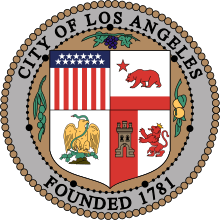Civic Center, Los Angeles
The Civic Center neighborhood of Los Angeles, California, is the administrative core of the City of Los Angeles, County of Los Angeles, and a complex of city, county, state, and federal government offices, buildings, and courthouses.
Civic Center | |
|---|---|
_edit1.jpg) Los Angeles City Hall stands at the southern border of the Los Angeles Civic Center. | |
Civic Center Location within Downtown Los Angeles | |
| Coordinates: 34.054139°N 118.244659°W | |
| Country | |
| State | |
| County | |
| City | |
| Area code(s) | 213 |
Location

The Civic Center is located in the northern part of Downtown Los Angeles, bordering Bunker Hill, Little Tokyo, Chinatown, and the Historic Core of the old Downtown. Depending on various district definitions, either the Civic Center or Bunker Hill also contains the Music Center and adjacent Walt Disney Concert Hall; some maps, for example, place the Dorothy Chandler Pavilion in the Civic Center but the Disney Concert Hall in Bunker Hill.
The Civic Center has the distinction of containing the largest concentration of government employees in the United States outside of Washington, D.C.[1] The reason for the high concentration is simple: Los Angeles is the most populous county in the United States and its second largest city, and houses several state and federal functions for the region.
Other locations
Los Angeles' 1949 master plan called for branch administrative centers throughout the city, as it was rapidly expanding.[2] In addition to the main civic center downtown, there is the West Los Angeles Civic Center in the Westside (built between 1957 and 1965) and the Van Nuys Civic Center in the San Fernando Valley, as well as a neighborhood city hall in San Pedro.[2][3]
Transportation
The Civic Center is served by numerous Metro buses, most of which run to adjacent Union Station, the 101 and 110 freeways, and the Metro Red Line and Purple Line's Civic Center/Grand Park Station are also in the vicinity. OCTA, Foothill Transit, DASH shuttles, Commuter Express and other municipal bus lines also serve the area.
The Regional Connector, currently under construction, will serve this area with two stations at Second/Flower and Second/Broadway station.
History and planning

Part of what is now the Civic Center occupies what was the central business district (CBD) in the 1880s and 1890s.
The Civic Center area is part of the ongoing Grand Avenue Project, which aims to develop existing parking lots in the area for residential and commercial use as well as create a Grand Park between the Los Angeles Music Center and City Hall.
In March 2017, the Los Angeles City Council approved a new Civic Center Master Plan. It details a full build out around city hall by the year 2032, specifically the east facing front. The CCMP schedules for a full tear down of Parker Center (torn down in 2019), L.A. City Hall's "south" building, and the Los Angeles Mall. The CCMP is to connect City Hall with its surrounding neighborhood and Little Tokyo.
The CCMP calls for active ground-floor uses, to stimulate the pedestrian traffic that the Civic Center currently lacks. Four new government and office towers are described in the plan as well as the planned Park 101 recreational area. A design approach idea to cover U.S. Highway 101 as a trench with green space above. Connecting with Union Station and Olvera Street. [4]
Landmarks
- Los Angeles City Hall
- Cathedral of Our Lady of the Angels
- Dorothy Chandler Pavilion
- Grand Park
- Houdon Statue of George Washington
- Los Angeles Music Center
- Triforium
- Union Station
- Walt Disney Concert Hall
Government and administrative buildings
- Los Angeles City Hall
- Kenneth Hahn Hall of Administration
- Stanley Mosk L.A. Courthouse
- Hall of Records
- Law Library
- Federal Court House
- Parker Center
- Caltrans District 7 Headquarters
- Alameda St. Detention Facility
- John Ferraro Building, Los Angeles Department of Water and Power
- Clara Shortridge Foltz Criminal Justice Center
County representation
The Los Angeles County Department of Health Services operates the Central Health Center in Downtown Los Angeles, serving the Civic Center.[5]
References
- "Civic Center". Downtown LA Walks. Archived from the original on 26 February 2012. Retrieved 1 November 2012.
- West Los Angeles Civic Center
- City Hall & Neighborhood City Halls
- "A Look at the Civic Center of the Future". 5 April 2017.
- "Central Health Center." Los Angeles County Department of Health Services. Retrieved on March 18, 2010.
